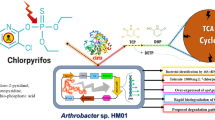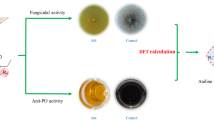Abstract
Chloropyridinyl neonicotinoid insecticides play a major role in crop protection and flea control on cats and dogs. Imidacloprid, thiacloprid and acetamiprid have in common the 6-chloro-3-pyridinylmethyl group but differ in the nitroguanidine or cyanoamidine substituent on an acyclic or cyclic moiety. Our previous study found that Stenotrophomonas maltophilia CGMCC 1.1788 could hydroxylate imidacloprid to 5-hydroxy imidacloprid, and 5-hydroxy imidacloprid was easily converted to 10–19 times higher insecticidal olefin imidacloprid against aphid or whitefly. Acetamiprid could be transformed by S. maltophilia to form N-demethylation product(IM 2-1). In this paper, we examined S. maltophilia CGMCC 1.1788’s ability of transformation of thiacloprid. S. maltophilia CGMCC 1.1788 can hydroxylate thiacloprid to 4-hydroxy thiacloprid characterized by HPLC-MS/MS and NMR analysis, however 4-hydroxy thiacloprid could not be converted to olefin thiacloprid under acid conditions like imidacloprid, whereas oxidized and decyonated simultaneously to form 4-ketone thiacloprid imine in alkaline solution. Bioassays indicated that 4-hydroxy thiacloprid had 156 times lower insecticidal activity than thiacloprid, and the ketone-imine derivative almost had no toxicity towards aphid. Though both imidacloprid and thiacloprid are hydroxylated by S. maltophilia CGMCC 1.1788 at the same carbon atom position, however the structural difference between in imidacloprid and thiacloprid, originate the entire discrepancy in bioefficacy of metabolite and its further degrading pathway. These results explain that why thiacloprid is classified as not relevant grade for soil and seed applications, whereas imidacloprid is recommended and acetamiprid is limited.





Similar content being viewed by others
References
Chen T, Dai YJ, Ding JF, Yuan S (2008) N-demethylation of neonicotinoid insecticide acetamiprid by bacterium Stenotrophomonas maltophilia CGMCC1.1788. Biodegradation 19:651–658. doi:10.1007/s10532-007-9170-2
Dai YJ, Yuan S, Ge F, Chen T, Xu SC, Ni JP (2006) Microbial hydroxylation of imidacloprid for the synthesis of highly insecticidal olefin imidacloprid. Appl Microbiol Biotechnol 71:927–934. doi:10.1007/s00253-005-0223-3
Dai YJ, Chen T, Ge F, Huan Y, Yuan S, Zhu FF (2007) Enhanced hydroxylation of imidacloprid by Stenotrophomonas maltophilia upon addition of sucrose. Appl Microbiol Biotechnol 74:995–1000. doi:10.1007/s00253-006-0762-2
Elbert A, Erdelen C, Hattori Y, Kuhnhold J, Nauen R, Schmidt HW (2000) Thiacloprid: a novel neonicotinoid insecticide for foliar application. Proc British Crop Prot Conf—Pests and Diseases, BCPC, Farnham, Surrey, Surrey, UK, pp 21–26
Elbert A, Haas M, Springer B, Thielert W, Nauen R (2008) Applied aspects of neonicotinoid uses in crop protection. Pest Manag Sci 64:1099–1105. doi:10.1002/ps.1616
Horowitz A, Mendelson Z, Weintraub P, Ishaaya I (1998) Comparative toxicity of foliar and systemic applications of acetamiprid and imidacloprid against the cotton whitefly, Bemisia tabaci (Hemiptera: Aleyrodidae). Bull Entomol Res 88(4):437–442
Jouben N, Heckel DG, Haas M, Schuphan I, Schmidt B (2008) Metabolism of imidacloprid and DDT by P450 CYP6G1 expressed in cell cultures of Nicotiana tabacum suggests detoxification of these insecticides in Cyp6g1-overexpressing strains of Drosophila melanogaster, leading to resistance. Pest Manag Sci 64:65–73. doi:10.1002/ps.1472
Klein O (2001) Behavior of thiacloprid (YRC 2894) in plants and animals. Pflanzenschutz-Nachichten Bayer 54:209–240. Available on http://www.agro.bayer.com
Krohn J (2001) Behavior of thiacloprid in the environment. Pflanzenschutz-Nachrichten Bayer 54(2):281–289. Available on http://www.agro.bayer.com
Krohn J, Hellpointner E (2002) Environmental fate of imidacloprid. Pflanzenschutz-Nachr Bayer 55:3–26. Available on http://www.agro.bayer.com
Matsuzaki F, Wariishi H (2004) Functional diversity of cytochrome P450 s of the white-rot fungus Phanerochaete chrysosporium. Biochem Biophys Res Commun 324:387–393. doi:10.1016/j.bbrc.2004.09.062
Nauen R, Rechmann U, Armborst S, Stupp HP, Elbert A (1999) Whitefly-active metabolites of imidacloprid: biological efficacy and translocation in cotton plants. Pestic Sci 55:265–271. doi:10.1002/(SICI)1096-9063(199903)55:3<265::AID-PS891>3.0.CO;2-C
Nauen R, Ebbinghaus-Kintscher U, Salgado VL, Kaussmannb M (2003) Thiamethoxam is a neonicotinoid precursor converted to clothianidin in insects and plants. Pestic Biochem Physiol 76:55–59. doi:10.1016/S0048-3575(03)00065-8
Rouchaud J, Gustin F, Wauters A (1994) Soil biodegradation and leaf transfer of insecticide imidacloprid applied in seed dressing in sugar beet crops. Bull Environ Contam Toxicol 53:344–350. doi:10.1007/BF00197224
Sato A, Watanabe T, Watanabe Y, Harazono K, Fukatsu T (2002) Screening for basidiomycetous fungi capable of degrading 2, 7-dichlorodibenzo-p-dioxin. FEMS Microbiol Lett 213:213–217. doi:10.1111/j.1574-6968.2002.tb11308.x
Schulz-Jander D, Casida J (2002) Imidacloprid insecticide metabolism:human cytochrome P450 isozymes differ in selectivity for imidazolidine oxidation versus nitroimine reduction. Toxicol Lett 132:65–70. doi:10.1016/S0378-4274(02)00068-1
Tomizawa M, Lee DL, Casida JE (2000) Neonicotinoid insecticides: molecular features conferring selectivity for insect versus mammalian nicotinic receptors. J Agric Food Chem 48:6016–6024. doi:10.1021/jf000873c
Acknowledgments
We are thankful for the support from the Key Basic Research Program of Jiangsu Higher Education Institution of China (06KJA21016) and the Natural Science Foundation of Jiangsu, China (BK2006574). We are thankful for suggestions and for the LC-MS analysis by Dr. Ji-hua Liu of the China Pharmaceutical University. We are also thankful for the NMR analysis by Dr. Jia-Hong Zhou from the analytical centre in Nanjing Normal University.
Author information
Authors and Affiliations
Corresponding author
Rights and permissions
About this article
Cite this article
Zhao, YJ., Dai, YJ., Yu, CG. et al. Hydroxylation of thiacloprid by bacterium Stenotrophomonas maltophilia CGMCC1.1788. Biodegradation 20, 761–768 (2009). https://doi.org/10.1007/s10532-009-9264-0
Received:
Accepted:
Published:
Issue Date:
DOI: https://doi.org/10.1007/s10532-009-9264-0




